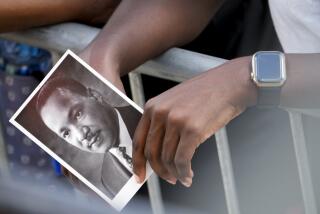In ‘Sherman’s March,’ the brutal Civil War assault is retraced
Call it the mother of all military surges. It spread destruction and terror, shortened a war, and gave rise to both a triumphant legend and deep-set resentment that poisoned the peace.
And now the History Channel has given it a first-rate treatment, set for broadcast Sunday: “Sherman’s March,” the tale of Union Gen. William Tecumseh Sherman and his five-week assault from Atlanta to the sea and then north to trap Confederate Gen. Robert E. Lee.
His troops called him “Uncle Billy,” but white Southerners called him the devil in a blue uniform.
The march introduced a new concept to the already brutal conflict between the states: total war, where the distinctions between combatants and civilians is blurred.
Civil War documentaries are inevitably judged against the monumental work by Ken Burns. “Sherman’s March,” different in tone and approach, more than holds its own.
Whereas Burns used period photographs and regional music, “Sherman’s March” leans on reenactments, maps and, like Burns, academic talking heads. If there is a quibble, it’s that the music tends to distract, not enhance, the effect.
The audacity of the maneuver remains startling. Sherman led 60,000 soldiers on a fast-paced march without supply lines or a way to communicate with his superiors. To survive, his soldiers foraged local crops, burned homes and farms, and terrorized the civilians in their path.
There are nuggets in the overall tale: the Union soldier who kept a diary, the Southern widow who desperately tried to hide her valuables from the foraging troops, the Union officer who left fleeing slaves stranded on the far side of a wide and fast-moving river, dooming many to death. The horror and pathos of the war is made real.
The relationship between Sherman and Gen. Ulysses S. Grant was complex. Before the war, Sherman was rumored to be crazy, Grant a drunk. Frustrated at stalemate on the battlefield, President Lincoln looked to the pair to provide him the victory he needed to win reelection in 1864.
Sherman had a grandiosity to match his boldness. He wrote Lincoln, “I beg to present to you as a Christmas gift the city of Savannah.”
When the Confederate Army tried to slow Sherman by burying crude bombs that would explode under soldiers’ feet, Sherman ordered Confederate prisoners to clear them. When Union prisoners had their throats slit, Sherman ordered a Confederate prisoner executed.
“Sherman’s March” seems likely to appeal to a large audience, including Civil War buffs and history majors. It should also appeal to anyone interested in the vexing, morally complex issues that arise in armed conflict: in the woods of the American South or in desert regions half a world away.
*
*
‘Sherman’s March’
Where: The History Channel
When: 9 to 11 p.m. Sunday
Rating: TV-PG-V (may be unsuitable for young children, with an advisory for violence)
More to Read
Sign up for Essential California
The most important California stories and recommendations in your inbox every morning.
You may occasionally receive promotional content from the Los Angeles Times.










